Ace Institute of Management BBA Project: Indian vs Nepali Products
VerifiedAdded on 2022/01/22
|68
|12919
|240
Project
AI Summary
This BBA project, submitted to Ace Institute of Management, Pokhara University, examines Nepali customer preferences for Indian and Nepali products. The research explores factors such as price, quality, availability, and design, to understand why Nepali products may struggle in the market. The project includes an introduction, literature review, methodology, data analysis, findings, and conclusion. The study utilizes both primary and secondary data, employing surveys and statistical analysis to assess consumer behavior and preferences. The findings highlight consumer attitudes towards Nepali and Indian products, exploring influences on purchasing decisions, including factors like patriotism, brand reputation, and product quality. The project aims to identify key drivers behind consumer choices and offer implications for the development of Nepali products. The research involves the collection and analysis of data from a diverse group of respondents to understand the current market dynamics and consumer behavior related to the preference for Indian and Nepali products.
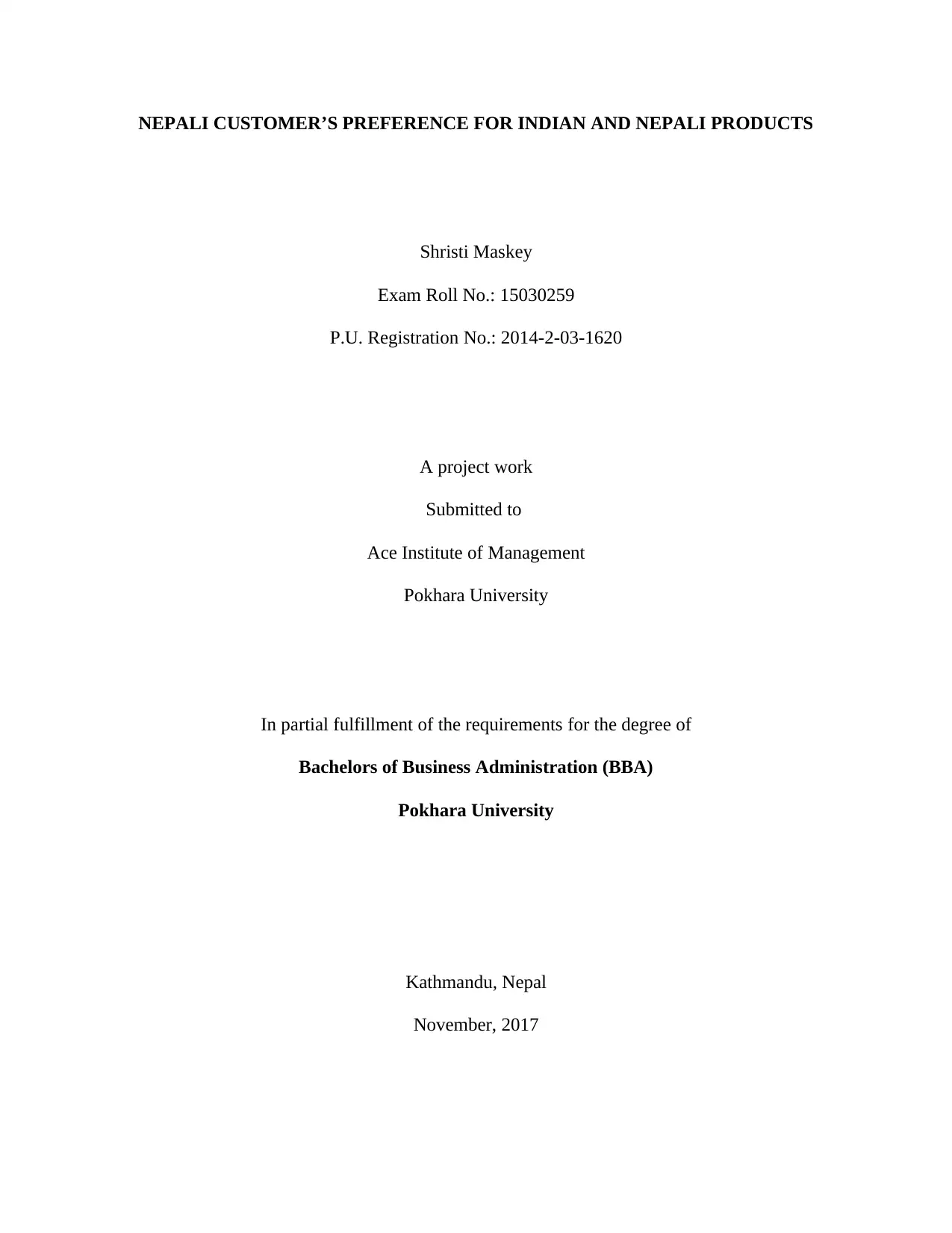
NEPALI CUSTOMER’S PREFERENCE FOR INDIAN AND NEPALI PRODUCTS
Shristi Maskey
Exam Roll No.: 15030259
P.U. Registration No.: 2014-2-03-1620
A project work
Submitted to
Ace Institute of Management
Pokhara University
In partial fulfillment of the requirements for the degree of
Bachelors of Business Administration (BBA)
Pokhara University
Kathmandu, Nepal
November, 2017
Shristi Maskey
Exam Roll No.: 15030259
P.U. Registration No.: 2014-2-03-1620
A project work
Submitted to
Ace Institute of Management
Pokhara University
In partial fulfillment of the requirements for the degree of
Bachelors of Business Administration (BBA)
Pokhara University
Kathmandu, Nepal
November, 2017
Paraphrase This Document
Need a fresh take? Get an instant paraphrase of this document with our AI Paraphraser
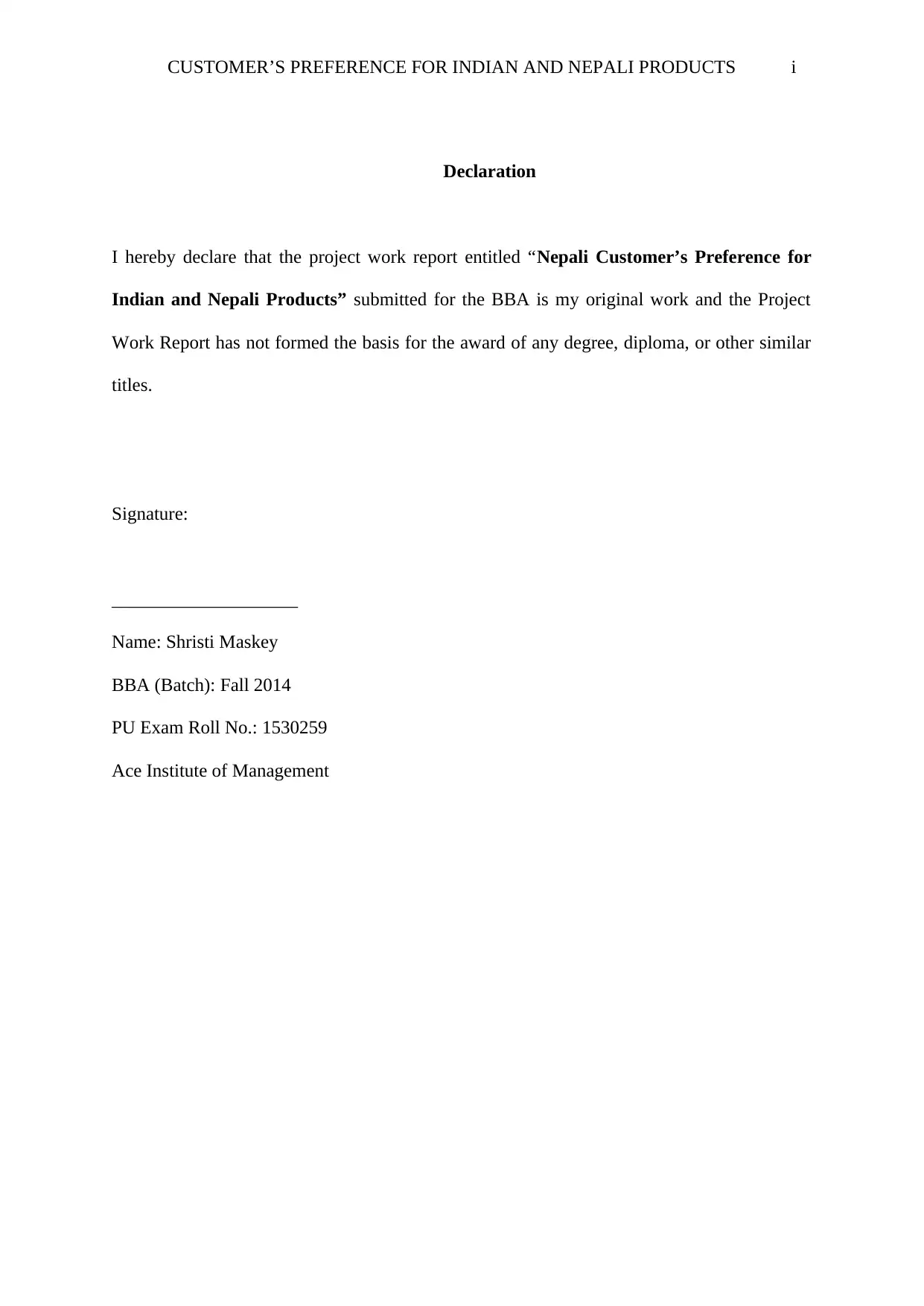
CUSTOMER’S PREFERENCE FOR INDIAN AND NEPALI PRODUCTS i
Declaration
I hereby declare that the project work report entitled “Nepali Customer’s Preference for
Indian and Nepali Products” submitted for the BBA is my original work and the Project
Work Report has not formed the basis for the award of any degree, diploma, or other similar
titles.
Signature:
____________________
Name: Shristi Maskey
BBA (Batch): Fall 2014
PU Exam Roll No.: 1530259
Ace Institute of Management
Declaration
I hereby declare that the project work report entitled “Nepali Customer’s Preference for
Indian and Nepali Products” submitted for the BBA is my original work and the Project
Work Report has not formed the basis for the award of any degree, diploma, or other similar
titles.
Signature:
____________________
Name: Shristi Maskey
BBA (Batch): Fall 2014
PU Exam Roll No.: 1530259
Ace Institute of Management

CUSTOMER’S PREFERENCE FOR INDIAN AND NEPALI PRODUCTS ii
BONAFIDE CERTIFICATE
This is to certify that the project report titled
“Nepali Customer’s Preference for Indian and Nepali Products”
is the bonafide work of
Shristi Maskey
who carried out the summer project proposal work under my supervision. This report is
forwarded for examination
…….……………….
Signature
Amit Koirala
Supervisor
…………………….
Signature
Ramesh Chauhan
Program Director
Name of the external Examiner:
Date:
BONAFIDE CERTIFICATE
This is to certify that the project report titled
“Nepali Customer’s Preference for Indian and Nepali Products”
is the bonafide work of
Shristi Maskey
who carried out the summer project proposal work under my supervision. This report is
forwarded for examination
…….……………….
Signature
Amit Koirala
Supervisor
…………………….
Signature
Ramesh Chauhan
Program Director
Name of the external Examiner:
Date:
⊘ This is a preview!⊘
Do you want full access?
Subscribe today to unlock all pages.

Trusted by 1+ million students worldwide
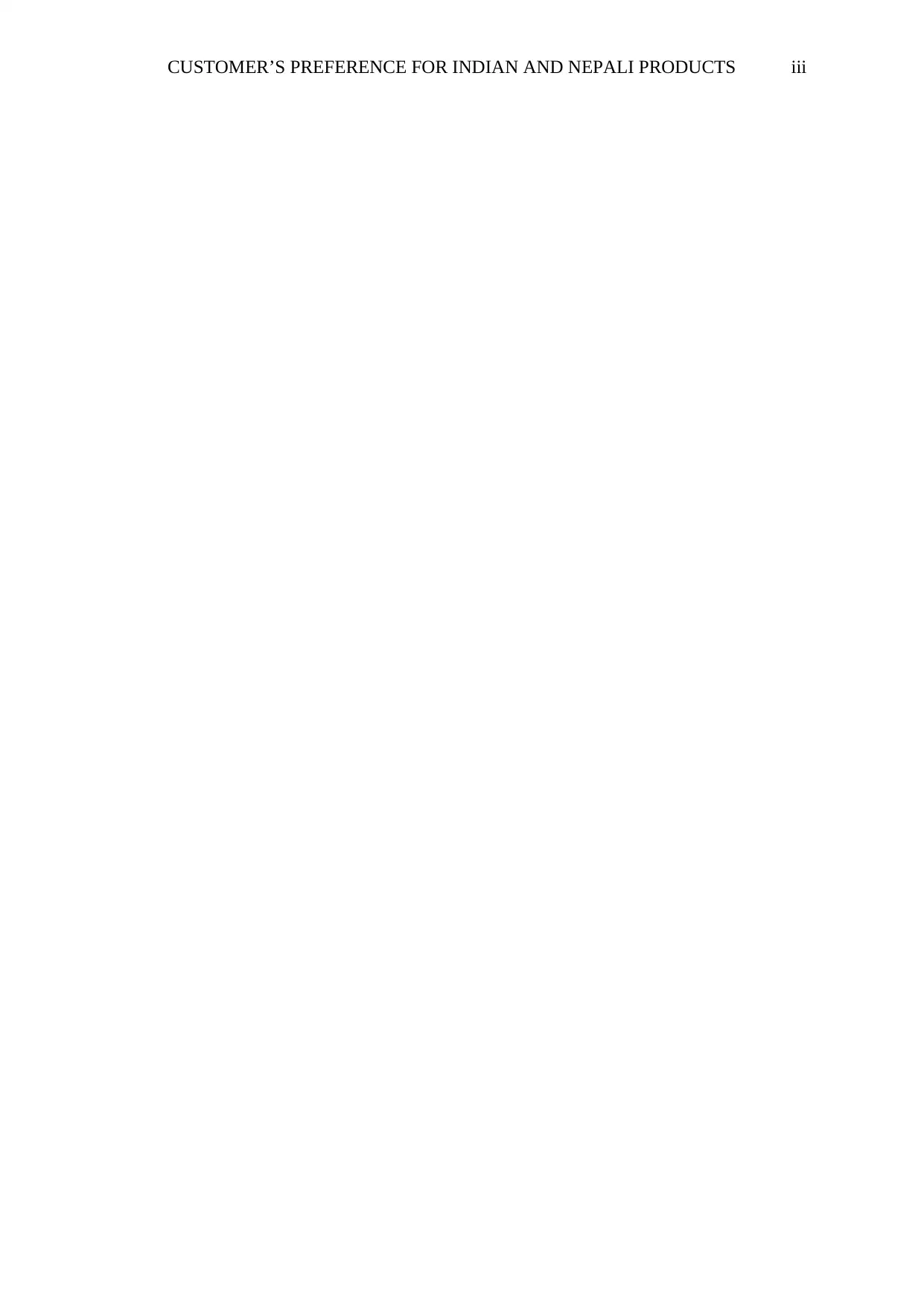
CUSTOMER’S PREFERENCE FOR INDIAN AND NEPALI PRODUCTS iii
Paraphrase This Document
Need a fresh take? Get an instant paraphrase of this document with our AI Paraphraser

CUSTOMER’S PREFERENCE FOR INDIAN AND NEPALI PRODUCTS iii
Acknowledgement
I would like to thank Mrs. Sharmila Maharjan for giving us this wonderful opportunity to
work on this project as this project helped us to know why preference over Indian products are
increasing. I would also like to thank Pokhara University for including this as a subject because
this has helped me get an in-depth knowledge about the topic.
I would also like to thank Ace Institute of Management for giving us the support and
resources which were all required to help us complete this project work. I’d also like to take this
opportunity to thank not just the institution but also the teachers that gave us their valuable time
and support to help us with the project.
I am extremely grateful to all the candidates who were kind enough to allow me to
interview them and collect the data. I would also like to take this opportunity to thank each and
every person who has been directly or indirectly involved with this project and has helped me
complete this report. I would personally take the opportunity to thank my friends and family
who’ve helped and guided me a lot in the completion of this project work.
Acknowledgement
I would like to thank Mrs. Sharmila Maharjan for giving us this wonderful opportunity to
work on this project as this project helped us to know why preference over Indian products are
increasing. I would also like to thank Pokhara University for including this as a subject because
this has helped me get an in-depth knowledge about the topic.
I would also like to thank Ace Institute of Management for giving us the support and
resources which were all required to help us complete this project work. I’d also like to take this
opportunity to thank not just the institution but also the teachers that gave us their valuable time
and support to help us with the project.
I am extremely grateful to all the candidates who were kind enough to allow me to
interview them and collect the data. I would also like to take this opportunity to thank each and
every person who has been directly or indirectly involved with this project and has helped me
complete this report. I would personally take the opportunity to thank my friends and family
who’ve helped and guided me a lot in the completion of this project work.
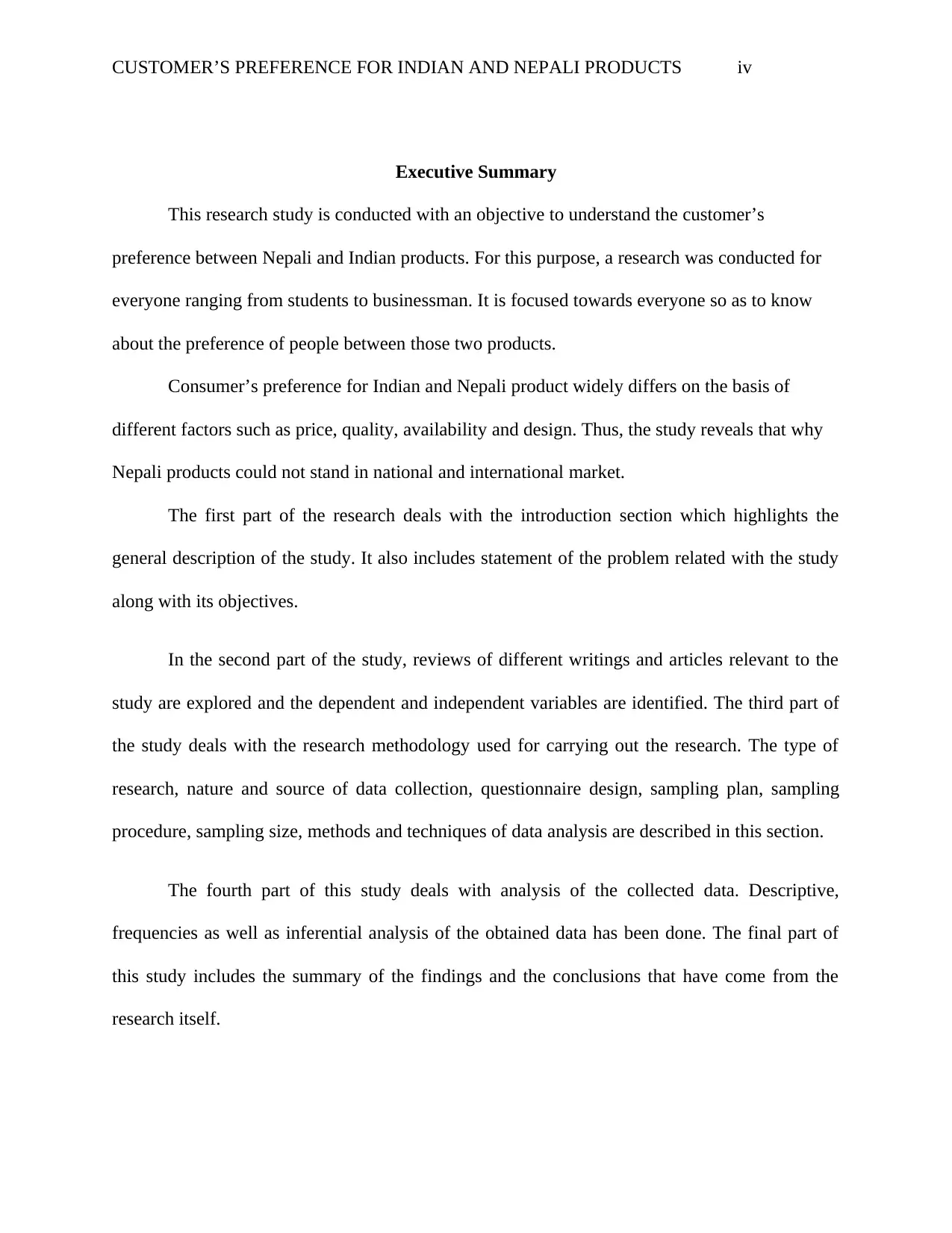
CUSTOMER’S PREFERENCE FOR INDIAN AND NEPALI PRODUCTS iv
Executive Summary
This research study is conducted with an objective to understand the customer’s
preference between Nepali and Indian products. For this purpose, a research was conducted for
everyone ranging from students to businessman. It is focused towards everyone so as to know
about the preference of people between those two products.
Consumer’s preference for Indian and Nepali product widely differs on the basis of
different factors such as price, quality, availability and design. Thus, the study reveals that why
Nepali products could not stand in national and international market.
The first part of the research deals with the introduction section which highlights the
general description of the study. It also includes statement of the problem related with the study
along with its objectives.
In the second part of the study, reviews of different writings and articles relevant to the
study are explored and the dependent and independent variables are identified. The third part of
the study deals with the research methodology used for carrying out the research. The type of
research, nature and source of data collection, questionnaire design, sampling plan, sampling
procedure, sampling size, methods and techniques of data analysis are described in this section.
The fourth part of this study deals with analysis of the collected data. Descriptive,
frequencies as well as inferential analysis of the obtained data has been done. The final part of
this study includes the summary of the findings and the conclusions that have come from the
research itself.
Executive Summary
This research study is conducted with an objective to understand the customer’s
preference between Nepali and Indian products. For this purpose, a research was conducted for
everyone ranging from students to businessman. It is focused towards everyone so as to know
about the preference of people between those two products.
Consumer’s preference for Indian and Nepali product widely differs on the basis of
different factors such as price, quality, availability and design. Thus, the study reveals that why
Nepali products could not stand in national and international market.
The first part of the research deals with the introduction section which highlights the
general description of the study. It also includes statement of the problem related with the study
along with its objectives.
In the second part of the study, reviews of different writings and articles relevant to the
study are explored and the dependent and independent variables are identified. The third part of
the study deals with the research methodology used for carrying out the research. The type of
research, nature and source of data collection, questionnaire design, sampling plan, sampling
procedure, sampling size, methods and techniques of data analysis are described in this section.
The fourth part of this study deals with analysis of the collected data. Descriptive,
frequencies as well as inferential analysis of the obtained data has been done. The final part of
this study includes the summary of the findings and the conclusions that have come from the
research itself.
⊘ This is a preview!⊘
Do you want full access?
Subscribe today to unlock all pages.

Trusted by 1+ million students worldwide
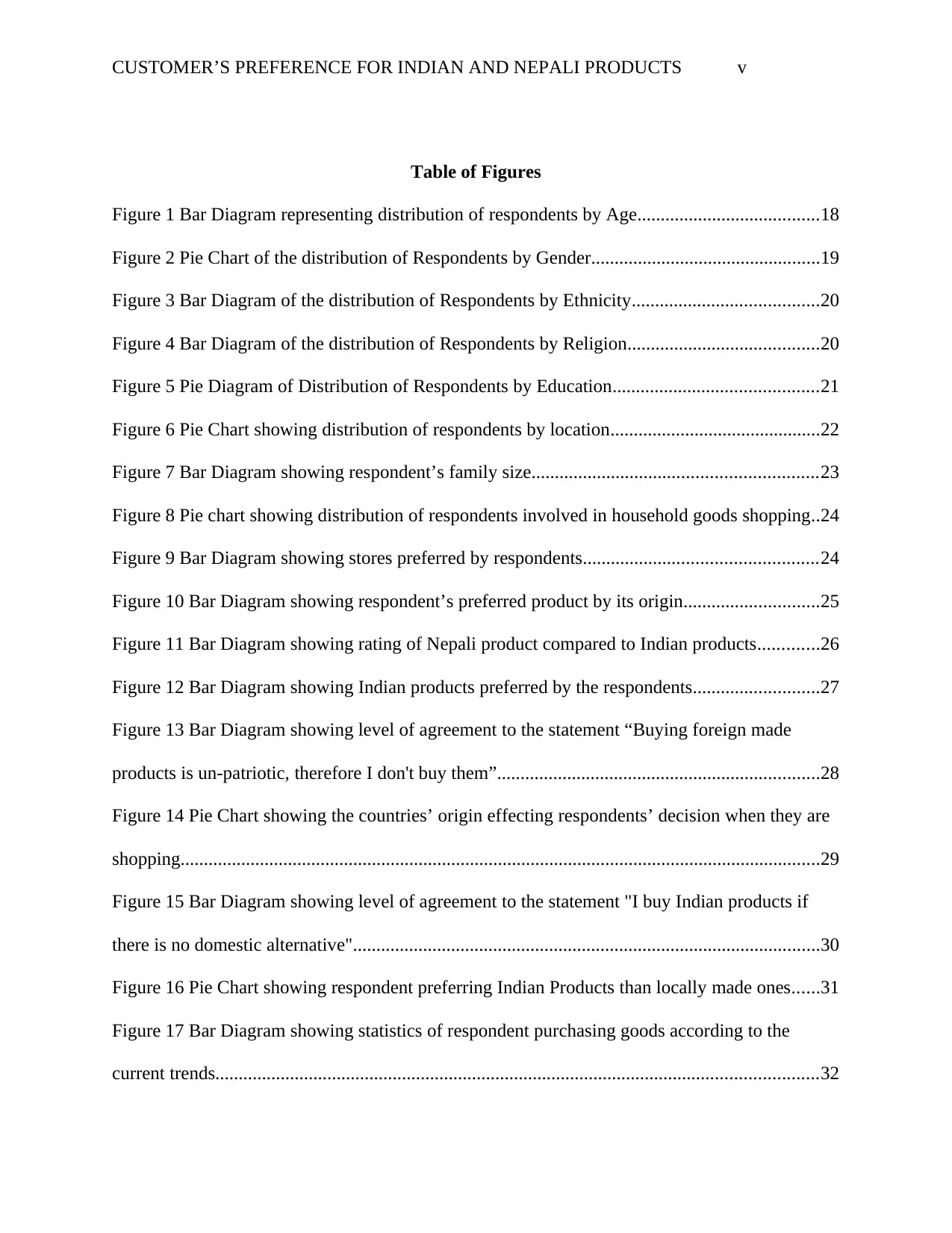
CUSTOMER’S PREFERENCE FOR INDIAN AND NEPALI PRODUCTS v
Table of Figures
Figure 1 Bar Diagram representing distribution of respondents by Age.......................................18
Figure 2 Pie Chart of the distribution of Respondents by Gender.................................................19
Figure 3 Bar Diagram of the distribution of Respondents by Ethnicity........................................20
Figure 4 Bar Diagram of the distribution of Respondents by Religion.........................................20
Figure 5 Pie Diagram of Distribution of Respondents by Education............................................21
Figure 6 Pie Chart showing distribution of respondents by location.............................................22
Figure 7 Bar Diagram showing respondent’s family size.............................................................23
Figure 8 Pie chart showing distribution of respondents involved in household goods shopping..24
Figure 9 Bar Diagram showing stores preferred by respondents..................................................24
Figure 10 Bar Diagram showing respondent’s preferred product by its origin.............................25
Figure 11 Bar Diagram showing rating of Nepali product compared to Indian products.............26
Figure 12 Bar Diagram showing Indian products preferred by the respondents...........................27
Figure 13 Bar Diagram showing level of agreement to the statement “Buying foreign made
products is un-patriotic, therefore I don't buy them”.....................................................................28
Figure 14 Pie Chart showing the countries’ origin effecting respondents’ decision when they are
shopping.........................................................................................................................................29
Figure 15 Bar Diagram showing level of agreement to the statement "I buy Indian products if
there is no domestic alternative"....................................................................................................30
Figure 16 Pie Chart showing respondent preferring Indian Products than locally made ones......31
Figure 17 Bar Diagram showing statistics of respondent purchasing goods according to the
current trends.................................................................................................................................32
Table of Figures
Figure 1 Bar Diagram representing distribution of respondents by Age.......................................18
Figure 2 Pie Chart of the distribution of Respondents by Gender.................................................19
Figure 3 Bar Diagram of the distribution of Respondents by Ethnicity........................................20
Figure 4 Bar Diagram of the distribution of Respondents by Religion.........................................20
Figure 5 Pie Diagram of Distribution of Respondents by Education............................................21
Figure 6 Pie Chart showing distribution of respondents by location.............................................22
Figure 7 Bar Diagram showing respondent’s family size.............................................................23
Figure 8 Pie chart showing distribution of respondents involved in household goods shopping..24
Figure 9 Bar Diagram showing stores preferred by respondents..................................................24
Figure 10 Bar Diagram showing respondent’s preferred product by its origin.............................25
Figure 11 Bar Diagram showing rating of Nepali product compared to Indian products.............26
Figure 12 Bar Diagram showing Indian products preferred by the respondents...........................27
Figure 13 Bar Diagram showing level of agreement to the statement “Buying foreign made
products is un-patriotic, therefore I don't buy them”.....................................................................28
Figure 14 Pie Chart showing the countries’ origin effecting respondents’ decision when they are
shopping.........................................................................................................................................29
Figure 15 Bar Diagram showing level of agreement to the statement "I buy Indian products if
there is no domestic alternative"....................................................................................................30
Figure 16 Pie Chart showing respondent preferring Indian Products than locally made ones......31
Figure 17 Bar Diagram showing statistics of respondent purchasing goods according to the
current trends.................................................................................................................................32
Paraphrase This Document
Need a fresh take? Get an instant paraphrase of this document with our AI Paraphraser
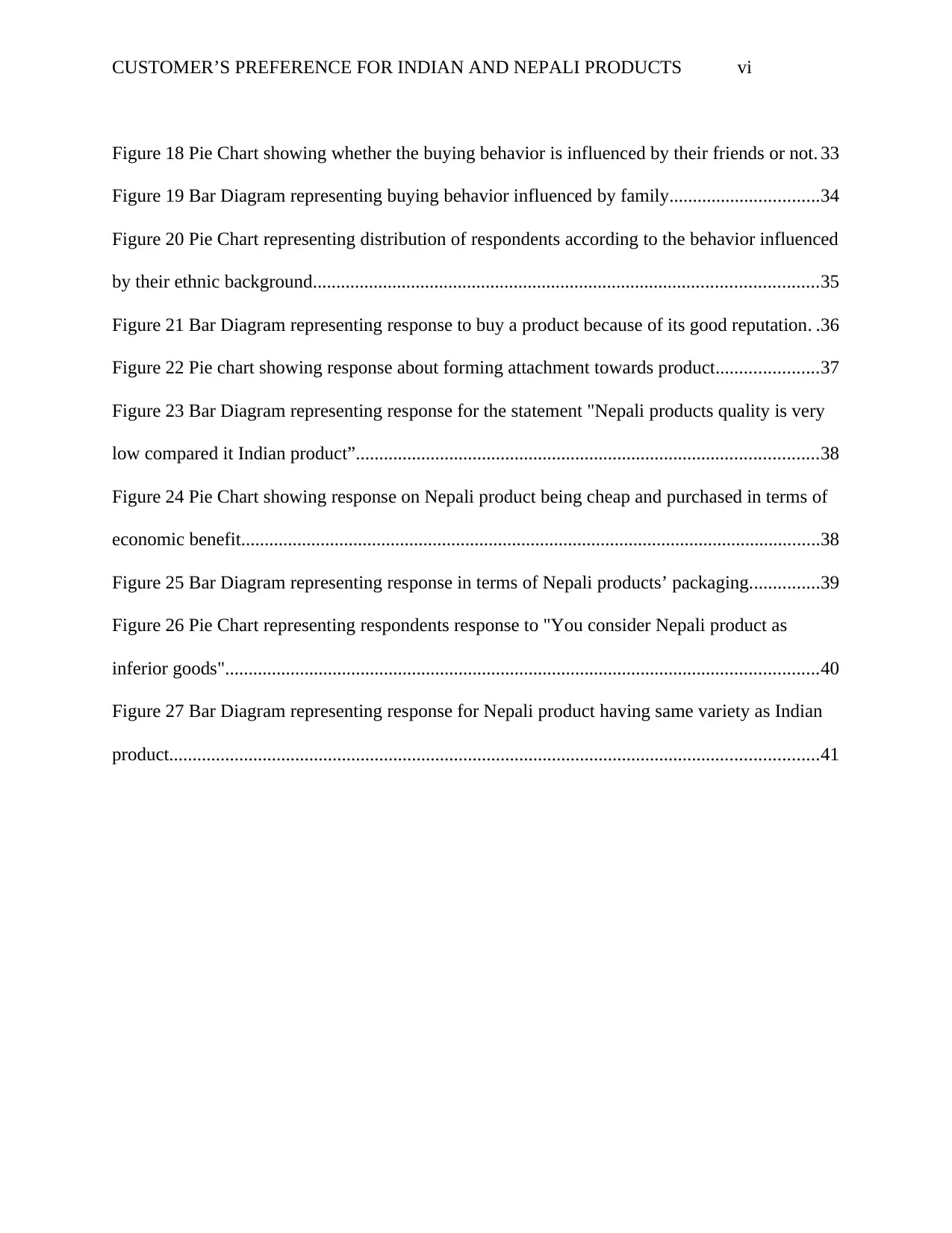
CUSTOMER’S PREFERENCE FOR INDIAN AND NEPALI PRODUCTS vi
Figure 18 Pie Chart showing whether the buying behavior is influenced by their friends or not. 33
Figure 19 Bar Diagram representing buying behavior influenced by family................................34
Figure 20 Pie Chart representing distribution of respondents according to the behavior influenced
by their ethnic background............................................................................................................35
Figure 21 Bar Diagram representing response to buy a product because of its good reputation. .36
Figure 22 Pie chart showing response about forming attachment towards product......................37
Figure 23 Bar Diagram representing response for the statement "Nepali products quality is very
low compared it Indian product”...................................................................................................38
Figure 24 Pie Chart showing response on Nepali product being cheap and purchased in terms of
economic benefit............................................................................................................................38
Figure 25 Bar Diagram representing response in terms of Nepali products’ packaging...............39
Figure 26 Pie Chart representing respondents response to "You consider Nepali product as
inferior goods"...............................................................................................................................40
Figure 27 Bar Diagram representing response for Nepali product having same variety as Indian
product...........................................................................................................................................41
Figure 18 Pie Chart showing whether the buying behavior is influenced by their friends or not. 33
Figure 19 Bar Diagram representing buying behavior influenced by family................................34
Figure 20 Pie Chart representing distribution of respondents according to the behavior influenced
by their ethnic background............................................................................................................35
Figure 21 Bar Diagram representing response to buy a product because of its good reputation. .36
Figure 22 Pie chart showing response about forming attachment towards product......................37
Figure 23 Bar Diagram representing response for the statement "Nepali products quality is very
low compared it Indian product”...................................................................................................38
Figure 24 Pie Chart showing response on Nepali product being cheap and purchased in terms of
economic benefit............................................................................................................................38
Figure 25 Bar Diagram representing response in terms of Nepali products’ packaging...............39
Figure 26 Pie Chart representing respondents response to "You consider Nepali product as
inferior goods"...............................................................................................................................40
Figure 27 Bar Diagram representing response for Nepali product having same variety as Indian
product...........................................................................................................................................41
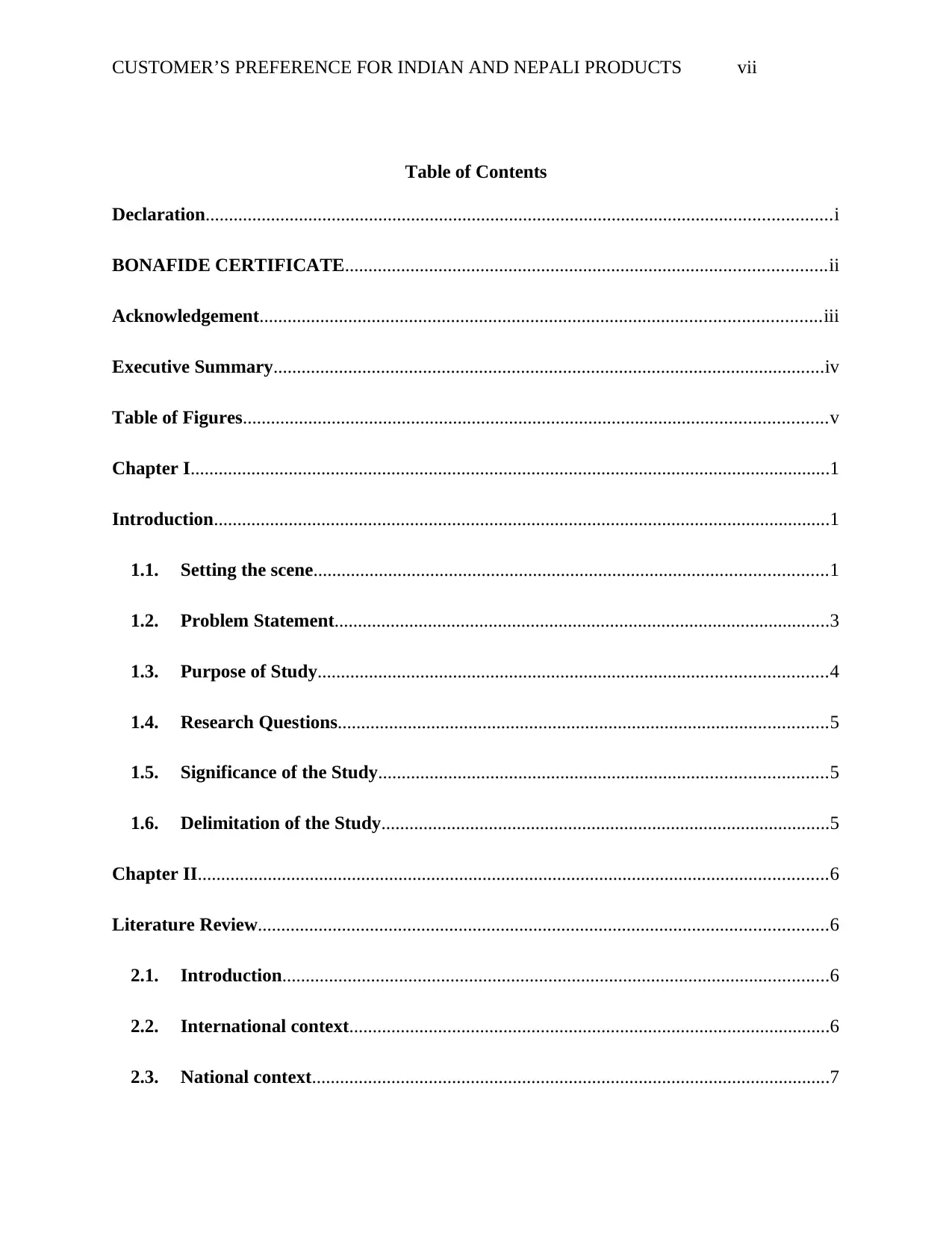
CUSTOMER’S PREFERENCE FOR INDIAN AND NEPALI PRODUCTS vii
Table of Contents
Declaration......................................................................................................................................i
BONAFIDE CERTIFICATE.......................................................................................................ii
Acknowledgement........................................................................................................................iii
Executive Summary......................................................................................................................iv
Table of Figures.............................................................................................................................v
Chapter I.........................................................................................................................................1
Introduction....................................................................................................................................1
1.1. Setting the scene..............................................................................................................1
1.2. Problem Statement..........................................................................................................3
1.3. Purpose of Study.............................................................................................................4
1.4. Research Questions.........................................................................................................5
1.5. Significance of the Study................................................................................................5
1.6. Delimitation of the Study................................................................................................5
Chapter II.......................................................................................................................................6
Literature Review..........................................................................................................................6
2.1. Introduction.....................................................................................................................6
2.2. International context.......................................................................................................6
2.3. National context...............................................................................................................7
Table of Contents
Declaration......................................................................................................................................i
BONAFIDE CERTIFICATE.......................................................................................................ii
Acknowledgement........................................................................................................................iii
Executive Summary......................................................................................................................iv
Table of Figures.............................................................................................................................v
Chapter I.........................................................................................................................................1
Introduction....................................................................................................................................1
1.1. Setting the scene..............................................................................................................1
1.2. Problem Statement..........................................................................................................3
1.3. Purpose of Study.............................................................................................................4
1.4. Research Questions.........................................................................................................5
1.5. Significance of the Study................................................................................................5
1.6. Delimitation of the Study................................................................................................5
Chapter II.......................................................................................................................................6
Literature Review..........................................................................................................................6
2.1. Introduction.....................................................................................................................6
2.2. International context.......................................................................................................6
2.3. National context...............................................................................................................7
⊘ This is a preview!⊘
Do you want full access?
Subscribe today to unlock all pages.

Trusted by 1+ million students worldwide
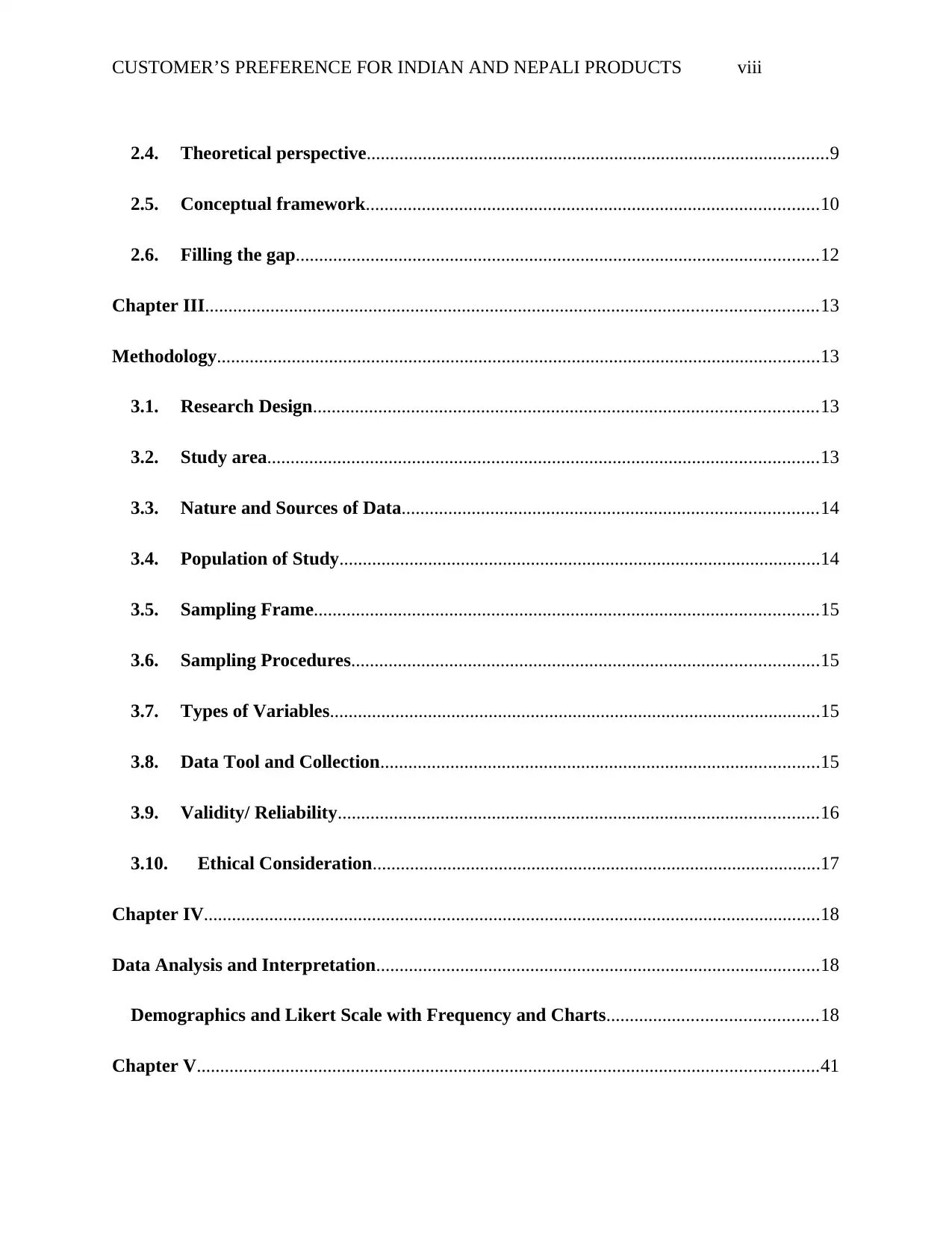
CUSTOMER’S PREFERENCE FOR INDIAN AND NEPALI PRODUCTS viii
2.4. Theoretical perspective...................................................................................................9
2.5. Conceptual framework.................................................................................................10
2.6. Filling the gap................................................................................................................12
Chapter III...................................................................................................................................13
Methodology.................................................................................................................................13
3.1. Research Design............................................................................................................13
3.2. Study area......................................................................................................................13
3.3. Nature and Sources of Data.........................................................................................14
3.4. Population of Study.......................................................................................................14
3.5. Sampling Frame............................................................................................................15
3.6. Sampling Procedures....................................................................................................15
3.7. Types of Variables.........................................................................................................15
3.8. Data Tool and Collection..............................................................................................15
3.9. Validity/ Reliability.......................................................................................................16
3.10. Ethical Consideration................................................................................................17
Chapter IV....................................................................................................................................18
Data Analysis and Interpretation...............................................................................................18
Demographics and Likert Scale with Frequency and Charts.............................................18
Chapter V.....................................................................................................................................41
2.4. Theoretical perspective...................................................................................................9
2.5. Conceptual framework.................................................................................................10
2.6. Filling the gap................................................................................................................12
Chapter III...................................................................................................................................13
Methodology.................................................................................................................................13
3.1. Research Design............................................................................................................13
3.2. Study area......................................................................................................................13
3.3. Nature and Sources of Data.........................................................................................14
3.4. Population of Study.......................................................................................................14
3.5. Sampling Frame............................................................................................................15
3.6. Sampling Procedures....................................................................................................15
3.7. Types of Variables.........................................................................................................15
3.8. Data Tool and Collection..............................................................................................15
3.9. Validity/ Reliability.......................................................................................................16
3.10. Ethical Consideration................................................................................................17
Chapter IV....................................................................................................................................18
Data Analysis and Interpretation...............................................................................................18
Demographics and Likert Scale with Frequency and Charts.............................................18
Chapter V.....................................................................................................................................41
Paraphrase This Document
Need a fresh take? Get an instant paraphrase of this document with our AI Paraphraser
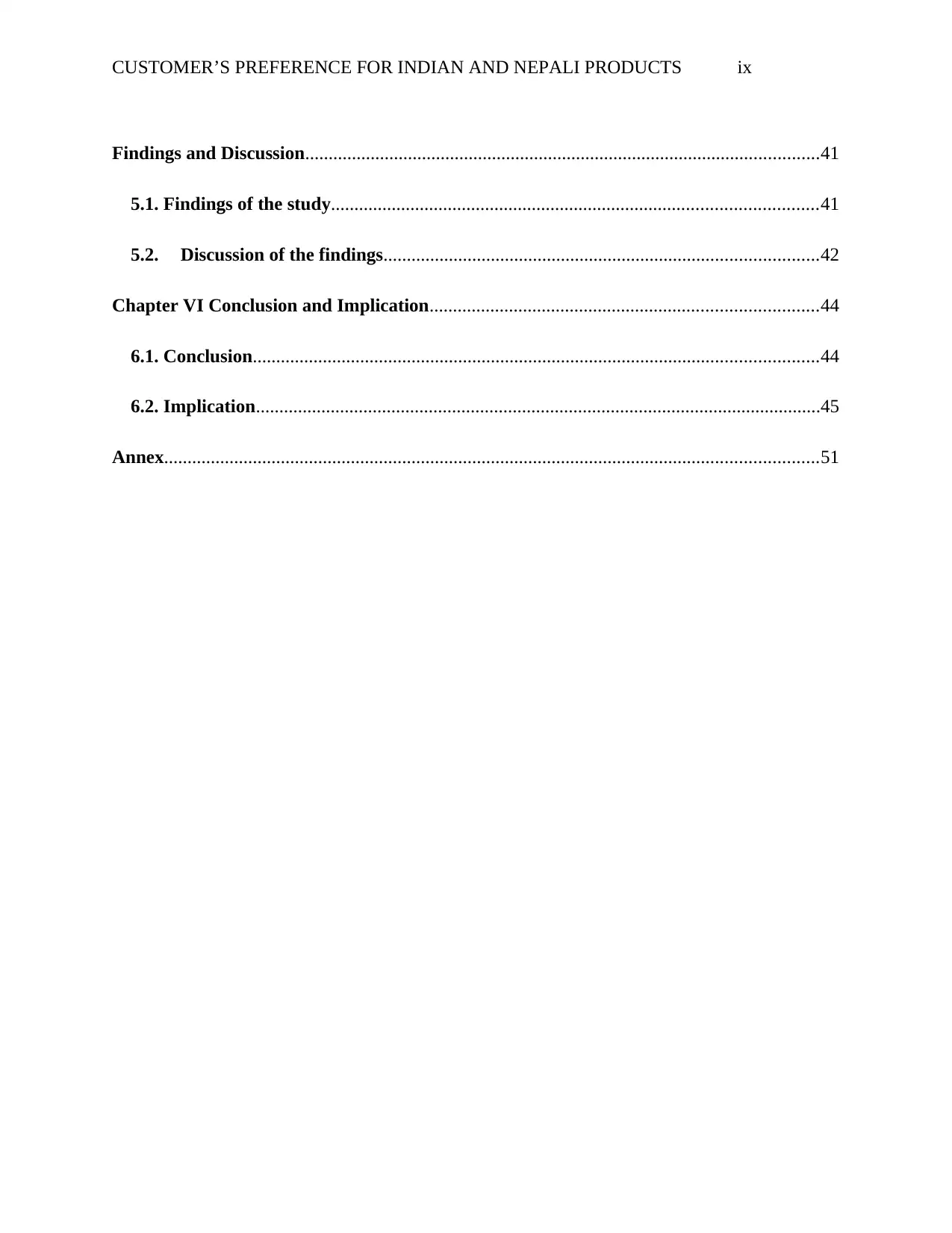
CUSTOMER’S PREFERENCE FOR INDIAN AND NEPALI PRODUCTS ix
Findings and Discussion..............................................................................................................41
5.1. Findings of the study........................................................................................................41
5.2. Discussion of the findings.............................................................................................42
Chapter VI Conclusion and Implication...................................................................................44
6.1. Conclusion.........................................................................................................................44
6.2. Implication.........................................................................................................................45
Annex............................................................................................................................................51
Findings and Discussion..............................................................................................................41
5.1. Findings of the study........................................................................................................41
5.2. Discussion of the findings.............................................................................................42
Chapter VI Conclusion and Implication...................................................................................44
6.1. Conclusion.........................................................................................................................44
6.2. Implication.........................................................................................................................45
Annex............................................................................................................................................51
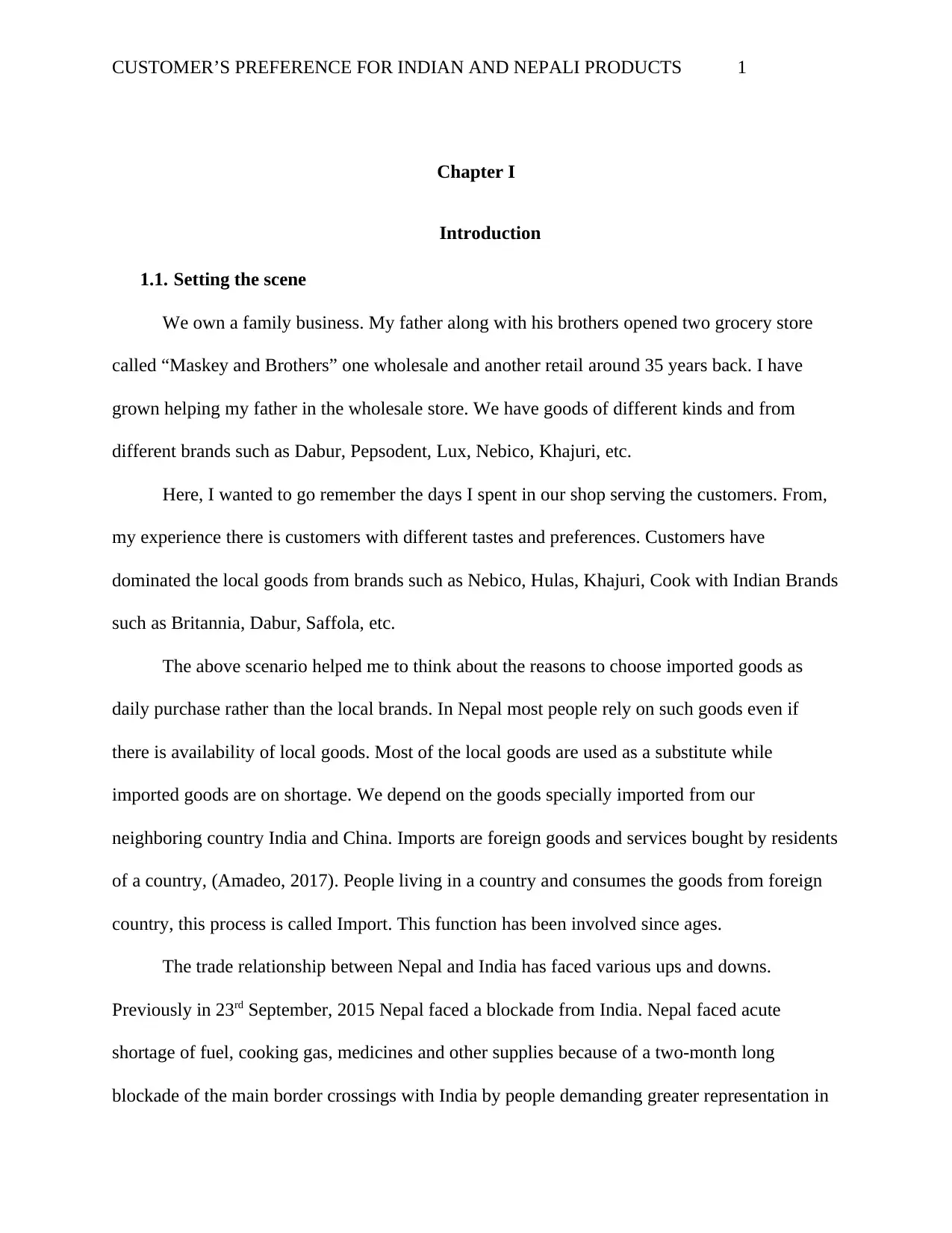
CUSTOMER’S PREFERENCE FOR INDIAN AND NEPALI PRODUCTS 1
Chapter I
Introduction
1.1. Setting the scene
We own a family business. My father along with his brothers opened two grocery store
called “Maskey and Brothers” one wholesale and another retail around 35 years back. I have
grown helping my father in the wholesale store. We have goods of different kinds and from
different brands such as Dabur, Pepsodent, Lux, Nebico, Khajuri, etc.
Here, I wanted to go remember the days I spent in our shop serving the customers. From,
my experience there is customers with different tastes and preferences. Customers have
dominated the local goods from brands such as Nebico, Hulas, Khajuri, Cook with Indian Brands
such as Britannia, Dabur, Saffola, etc.
The above scenario helped me to think about the reasons to choose imported goods as
daily purchase rather than the local brands. In Nepal most people rely on such goods even if
there is availability of local goods. Most of the local goods are used as a substitute while
imported goods are on shortage. We depend on the goods specially imported from our
neighboring country India and China. Imports are foreign goods and services bought by residents
of a country, (Amadeo, 2017). People living in a country and consumes the goods from foreign
country, this process is called Import. This function has been involved since ages.
The trade relationship between Nepal and India has faced various ups and downs.
Previously in 23rd September, 2015 Nepal faced a blockade from India. Nepal faced acute
shortage of fuel, cooking gas, medicines and other supplies because of a two-month long
blockade of the main border crossings with India by people demanding greater representation in
Chapter I
Introduction
1.1. Setting the scene
We own a family business. My father along with his brothers opened two grocery store
called “Maskey and Brothers” one wholesale and another retail around 35 years back. I have
grown helping my father in the wholesale store. We have goods of different kinds and from
different brands such as Dabur, Pepsodent, Lux, Nebico, Khajuri, etc.
Here, I wanted to go remember the days I spent in our shop serving the customers. From,
my experience there is customers with different tastes and preferences. Customers have
dominated the local goods from brands such as Nebico, Hulas, Khajuri, Cook with Indian Brands
such as Britannia, Dabur, Saffola, etc.
The above scenario helped me to think about the reasons to choose imported goods as
daily purchase rather than the local brands. In Nepal most people rely on such goods even if
there is availability of local goods. Most of the local goods are used as a substitute while
imported goods are on shortage. We depend on the goods specially imported from our
neighboring country India and China. Imports are foreign goods and services bought by residents
of a country, (Amadeo, 2017). People living in a country and consumes the goods from foreign
country, this process is called Import. This function has been involved since ages.
The trade relationship between Nepal and India has faced various ups and downs.
Previously in 23rd September, 2015 Nepal faced a blockade from India. Nepal faced acute
shortage of fuel, cooking gas, medicines and other supplies because of a two-month long
blockade of the main border crossings with India by people demanding greater representation in
⊘ This is a preview!⊘
Do you want full access?
Subscribe today to unlock all pages.

Trusted by 1+ million students worldwide
1 out of 68
Related Documents
Your All-in-One AI-Powered Toolkit for Academic Success.
+13062052269
info@desklib.com
Available 24*7 on WhatsApp / Email
![[object Object]](/_next/static/media/star-bottom.7253800d.svg)
Unlock your academic potential
Copyright © 2020–2025 A2Z Services. All Rights Reserved. Developed and managed by ZUCOL.





